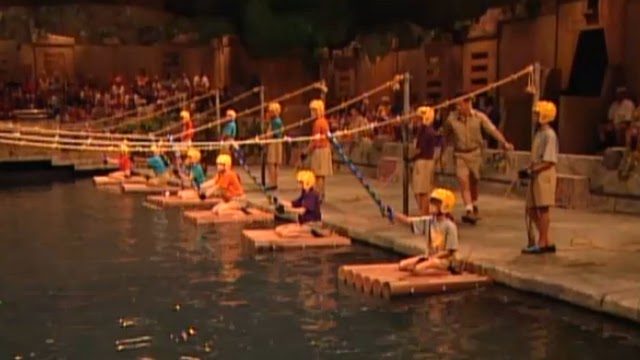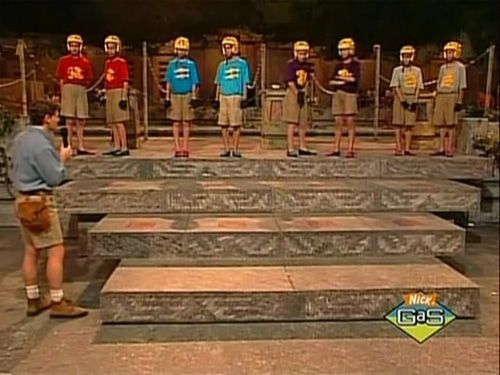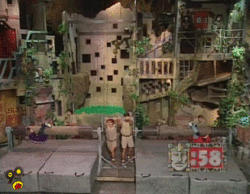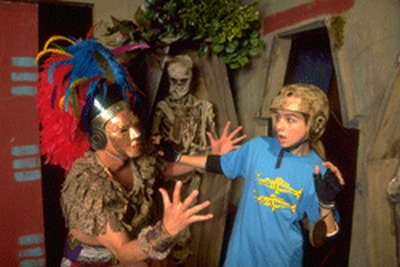Small-Screen 66 – #55: Legends of the Hidden Temple
(Nickelodeon, 1993-95)
 It’s a theme that we’ve returned to time and again on this page: I never had cable as a child. “90s kids” apparently remember a lot of early-90s Nickelodeon shows with fondness, but for the most part I only began to play catch-up in 1997, when my family started visiting my grandparents each summer. The sleepy seaside town of Nahcotta, Washington is an excellent place to binge-watch cartoons (and invent card games), so that’s just what I proceeded to do. In these month-long cram sessions, I absorbed re-runs of Doug and Hey, Arnold!, along with contemporary series such as CatDog, The Wild Thornberrys, and Rocket Power. But I missed the boat on some series I think I would have really enjoyed, particularly Are You Afraid of the Dark?…and today’s selection.
It’s a theme that we’ve returned to time and again on this page: I never had cable as a child. “90s kids” apparently remember a lot of early-90s Nickelodeon shows with fondness, but for the most part I only began to play catch-up in 1997, when my family started visiting my grandparents each summer. The sleepy seaside town of Nahcotta, Washington is an excellent place to binge-watch cartoons (and invent card games), so that’s just what I proceeded to do. In these month-long cram sessions, I absorbed re-runs of Doug and Hey, Arnold!, along with contemporary series such as CatDog, The Wild Thornberrys, and Rocket Power. But I missed the boat on some series I think I would have really enjoyed, particularly Are You Afraid of the Dark?…and today’s selection.
Skip forward to high school, circa 2004. After Cox launched a surprise “trial weekend” which granted us access to popular cable networks like The History Channel and Animal Planet, my parents sprang for a cable package. My lack of Nickelodeon was finally rectified, though perhaps a little late, as I had already aged-out of the channel’s typical demographic range. Instead, I grew devoted to shows on other networks – particularly The Sci-Fi Channel — but more on that later.
No, my true Nick-fueled 90’s nostalgiagasm finally came a year or so later, in 2005 or 2006. While house-/dog-sitting at my neighbors’ house over Christmas break, I paused to appreciate their media collection. In addition to all of the James Bond films on DVD, they had the most expansive cable package I had ever seen to that point, with some 900 channels. Clicking through, I chanced upon “Nick GaS,” a channel unlike any other. For the unfamiliar, “GaS” stands for “Games and Sports,” and the entire network was dedicated to re-running Nickelodeon game shows from the 1990s. Of which there were only about six (and that includes several versions of Double Dare). By the mid-2000s, the channel had apparently downsized in terms of actual human staff, opting for entirely automated programming. The result was an endless stream of commercial-free Guts, Figure It Out, and, yes, Legends of the Hidden Temple, played one after the other, with no human interruption, forever. And in those few, precious Yuletide GaS-fests (2005, 2006, and 2007, when the channel went off the air), I experienced the most highly-concentrated dose of “90s” I’ve yet felt (with the possible exception of listening to “My Slam will Jam On,” a mashup of the Titanic and Space Jam theme songs).
 It feels kind of silly to summarize a show to those who likely know more about it than I do, but here goes: Legends of the Hidden Temple is a jungle exploration-themed series hosted by the duo of Kirk Fogg (who sounds more like a Jules Verne character than a real person) and the show’s real star, a talking stone head named Olmec. Every episode begins with six competing teams of two children each (one boy, one girl). The teams are named for jungle creatures: Red Jaguars, Orange Iguanas, Green Monkeys, Blue Barracudas, Purple Parrots, and Silver Snakes.
It feels kind of silly to summarize a show to those who likely know more about it than I do, but here goes: Legends of the Hidden Temple is a jungle exploration-themed series hosted by the duo of Kirk Fogg (who sounds more like a Jules Verne character than a real person) and the show’s real star, a talking stone head named Olmec. Every episode begins with six competing teams of two children each (one boy, one girl). The teams are named for jungle creatures: Red Jaguars, Orange Iguanas, Green Monkeys, Blue Barracudas, Purple Parrots, and Silver Snakes.
In the show’s first round, all six pairs must cross “the Moat,” a long, shallow pool, by means of various obstacle-course contrivances. The first four teams across continue on in the competition. The two stragglers are elminated, but not before being sent home with the first round consolation prize. “Hidden Temple” prizes are generally defined by two characteristics: First, they are extremely 90s. Second, they are extremely cheap. This early in the game, the prize is typically a box of Nerds. Seriously.
Next, the four surviving teams face the “Steps of Knowledge.” In this segment, competitors stand atop a large stone staircase. Olmec reads a text passage with some expository information about that episode’s “artifact,” a Carmen Sandiego-style semi-historical MacGuffin (“The Electrified Key of Benjamin Franklin,” say, or “The Faberge Egg of Catherine the Great”). Olmec then asks the children “trivia” questions about the passage they’ve LITERALLY JUST HEARD. Kids with a knack for, you know, FORMING SHORT-TERM MEMORIES, buzz in with the correct response and get to descend one step. The first two teams to reach the base of the Steps of Knowledge get to proceed. The two more forgetful teams head home, often with a totally radical Walkman.
Now, the final two teams square off in the “Temple Games,” a trio of physical challenges involving any combination of swinging, climbing, crawling, tossing, catching, and collecting thematic knickknacks. The first two games pit a single member of each team against one another, and each game awards the victor half of a “Pendant of Life.” The final round sees both members of both teams going head-to-head, and awards a full Pendant. The team with fewer Pendants of Life departs with a boombox or a pair of Skechers sneakers.
But those lucky two who triumph in the Temple Games head forward…into the Hidden Temple itself. The Temple is a two-story obstacle course open at the front to allow spectators to see inside, similar to a dollhouse or ant farm. The course is made up of twelve or 13 rooms, with the arrangement swapped around slightly between episodes. One of these chambers holds the players’ quarry: the episode’s central artifact. Numerous doorways connect the various rooms, many of which are locked and can only be opened by completing a specific task related to the theme of a given room (assembling the shattered pieces of the “Shrine of the Silver Monkey,” for instance). Hidden throughout the labyrinth are three “temple guards,” surprisingly scary sentinels in Mesoamerican war-paint. The guards’ job is to leap out and scare the crap out of any young explorer unlucky enough to cross their path. If a player encounters a temple guard, said player must hand over one Pendant of Life (if the team won only 1½ Pendants in the Temple Games, the remaining half-pendant is hidden somewhere in the Temple). If a player has already lost their Pendant (or only has a half), but encounters another temple guard, that player is expelled from the Temple, and his or her partner has a chance to enter the temple and locate the artifact (obstacles and temple guards cleared out by the first teammate stay gone). Once a player successfully recovers the artifact, all remaining obstacles disappear…now, the daring explorer need only exit the temple before the time limit runs out.
Oh, yeah…there’s a three minute time limit. For the whole thing. Prizes are awarded based on how much progress the team makes: a low-tier prize for simply making it to the Temple, a more prestigious and expensive prize for locating the object, and the grand prize for successfully recovering the object AND exiting the Temple with it.
As for that fabulous Grand Prize, usually, winners receive all lower-level prizes, in addition to things like a CD-ROM encyclopedia set and a 10-speed bike or roller-blades. And on the rare occasions when teams successfully find the objects and escape the Temple, they win a trip to some “adventurous” destination, such as an island hotel or, perhaps more impressively, that nerd Mecca known only as Space Camp.
The appeal of Legends of the Hidden Temple lies in a few key factors:
-Olmec: Undoubtedly the best game-show host to date who also happens to be a disembodied head. Nifty puppeteering, glowing eyes and actor Dee Bradley Baker’s booming voice give life to Olmec, who easily steals the limelight from “co-host” Fogg.
 -Jungle theme: Nickelodeon had plenty of other shows focused on mouth-guarded preteens attempting feats of agility and athleticism. The tribal music, animal noises, vaguely historical influences and imposing “booby-trap” style Temple obstacles set Hidden Temple apart. The Indiana Jones motif is visually compelling and provides fertile ground for episode backstories and Temple Game challenge ideas, even if some of the “artifacts” seem like a bit of a stretch (“the Trojan Horseshoe,” “Genghis Khan’s cricket cage”).
-Jungle theme: Nickelodeon had plenty of other shows focused on mouth-guarded preteens attempting feats of agility and athleticism. The tribal music, animal noises, vaguely historical influences and imposing “booby-trap” style Temple obstacles set Hidden Temple apart. The Indiana Jones motif is visually compelling and provides fertile ground for episode backstories and Temple Game challenge ideas, even if some of the “artifacts” seem like a bit of a stretch (“the Trojan Horseshoe,” “Genghis Khan’s cricket cage”).
-Sheer comedy: I know I said back in the Always Sunny post that I don’t feel Schadenfreude often…but here it’s unavoidable. Watching children miss a simple recall question on the Steps of Knowledge, or take a wrong turn in the Hidden Temple and wander completely out to the studio floor again, despite Kirk Fogg’s anguished cries of “Turn around! No! The other way!” never loses its charm.
Nick GaS signed off in 2007, but Hidden Temple reruns can occasionally be seen on TeenNick’s “The 90s Are All That” block. Most of the episodes are also available to watch on YouTube (don’t tell ‘em I sent you). You can even buy semi-official gear to celebrate your favorite technicolor jungle animal team over at templeshirts.com .
Yes, even if the show goes off the air for good, the Hidden Temple will never truly disappear. After all, it lives on in the memories of 90s kids…who will forever speak of its Legends.
—
You can keep up with Brian’s Small-Screen 66 countdown here.









Pingback: 8 TV Comebacks to Look Out For in 2016